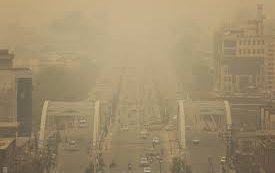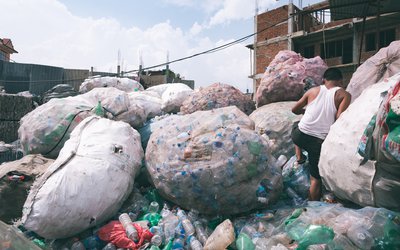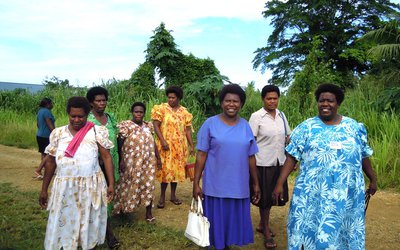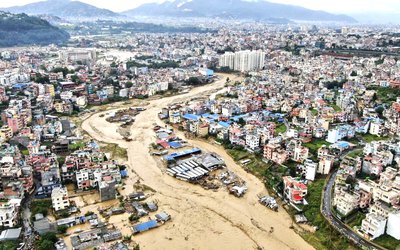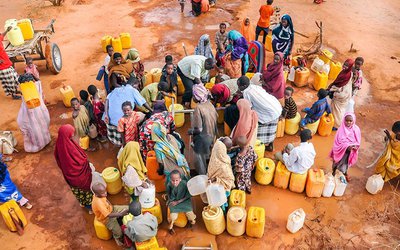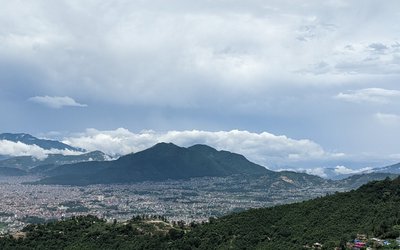
Nepal is a “supermarket” of disasters
Every year during the monsoon, climate-induced disasters bring pain and sorrow to the people of Nepal. Many people face large-scale devastation and loss of life and livelihood due to climate-induced disasters. The risks associated with disasters not only result in periodic crises but also exacerbate existing vulnerabilities, making it hard for families to ever escape the cycle of crisis.Inadequate disaster preparedness and response is one reason for this annual, and often lifetime, suffering.
In one way, Nepal is a disaster supermarket: all sorts of different disasters occur in every corner of the country. Data from the Ministry of Home Affairs reveals that during 2017-2018, 6,381 disaster events claimed 968 lives, injured 3,639 people, and affected 27255 families. It also damaged 20,741 houses and caused economic losses equivalent to NPR 6,838 Million. In terms of economic loss, fire alone accounts for 93.91% of the total loss, followed by landslides (2.80%), heavy rainfall (1.31%), flooding (0.89%) and windstorms (0.75%). The South Asian Climate Outlook Forum reported that the monsoon is likely to be normal this year, which means that the total rainfall will be around average, or 1600-1680 mm. Even within a normal monsoon year, however, intense and erratic rainfall sometimes results in flash floods, landslides, and severe inundation, all of which challenge and even undermine the livelihoods and overall well being of many people.
This year COVID-19 has added an additional challenge to the managers and actors who work to address climate-induced disaster risks. Natural disasters are growing in terms of number, frequency and magnitude every year, and their impacts will be devastating if disaster preparedness and response action plans are not aligned with COVID-19-related issues.Without immediate attention, COVID-19 is likely to increase the risks of climate-induced disaster and add to the burden of people living with climate-related shocks and misery.The uncontrolled spread of the virus will not only trigger a massive health and socio-economic shock but also weaken the resilience of those communities most at risk, inhibiting their ability to cope with the impacts of climate-induced disasters.
To prevent this potential catastrophe and build resilience warrantspreparing for and recovering from disasters while maintaining appropriate physical distance to check the likely transmission of the virus. COVID-19 changed the nature of disaster risk. Earlier disaster risk management strategies and action plans will not be applicable unless they are not modified in light of the COVID-19 context. The local governments where COVID-19 is becoming prevalent need robust disaster preparedness and response plans to reduce risk because the more vulnerability we can address now, the less uncertainty people will face in the future.There is a need to prepare for, respond to, and recover from both pandemic and climate-induced disasters in order to reduce risk and build resilience.
Challenges posed by COVID-19
COVID-19 has posed several challenges for the risk management of climate-induced disasters. As the global death toll of COVID-19and the number of cases in Nepal increases, governments and stakeholders are forgetting the scale of devastation and impacts associated with climate-induced disasters. It seems that COVID-19 is overshadowing the preparedness and response mechanism of climate-induced disasters. Government efforts and resources are currently inadequate to mitigate the impact of COVID-19 as well as longstanding disasters and the risk of mobilizing people in response to such disasters is very high if appropriate social distancing practices are not put in place.
Some of the considerations must be kept in mind if 2020 is not to be one of the most devastating years on record in terms of disaster management. First,as COVID-19 is the immediate disaster confronting them, stakeholders are forgetting the impacts of climate-induced disasters. The experiences of the last few years of disasters revealed that water-borne diseases are increasing during the monsoon as heavy rains and floods carry pathogens and toxic chemicals that contaminate drinking water supplies. The traditional wells in the plains of the Terai and emerging cities with poor drainage systems are particularly vulnerable. Ever hotter average temperatures are responsible for the emergence of vector-borne diseases such as dengue, malaria, kalazaar and Japanese encephalitis even in temperate areas where they did not used to flourish. Flash floods damage natural vegetation, physical infrastructures and human settlements,all effects that adversely affects people irrespective of gender and economic condition. Incessant rainfall normally triggers landslides, which often adversely affect agriculture, forest, inundate farmland, health, and physical infrastructures. Domestic fires impact food security and infrastructures and erode, while windstorms often sweep away standing crops, including both cash and cereal crops, thereby leading to heavy economic losses and food insecurity. People lose their lives to snakebite because few health facilities stock antidotes. Hailstorms damage ready-to-harvest crops, and thunderstorms and lightning are responsible for human fatalities and loss of assets. We cannot afford to neglect these dire consequences of climate-induced disaster in our preoccupation with COVID-19.
Second, COVID-19 overshadows the management of climate-induced disaster in various ways. With the focus on COVID-19-related response and recovery, there is a growing risk of overlooking risk management aspects of climate-induced disasters. The engagement of governments, the coordination and involvement of security forces, the management of search-and-rescue equipment and personnel, and the mobilizations of volunteers and security forces are all inadequate. Institutional memory building from past disasters like the floods of 2014 and 2017, the earthquake of 2015, the drought in the Karnali in 2016 and tornado in 2019 is almost non-existent.Institutional capacities among governments, development partners, humanitarian agencies and the Red Cross for risk management are inadequate.
Third,the risk of mobilizing people to carry out risk-reduction initiatives is great because transmission of the corona virus is a very real possibility. Building resilience by developing a social safety net is a huge challenge.People have to engage in many farm-based activities like crop harvesting and marketing of crops.This current season, spring, is the right time for the de-silting, repair and maintenance of canals in order to increase the irrigation efficiency. Community forests are generally open for a few days so that firewood can be collected and distributed. The tasks of ploughing the land, seedbed preparation and paddy plantation, and sowing maize, buckwheat, potatoes and seasonal vegetables are other springtime tasks. For risk-reduction initiatives, it is necessary to organize meetings, training, and a series of consultations. All these activities require the involvement of a large group of people, and it will be very challenging to mobilize them without risking the transmission of COVID-19.
Fourth,during large-scale disasters like floods and landslides, human displacement is common. It will be challenging to evacuate the vulnerable and house them in shelters in the context of this pandemic. Providing suitable treatment to a large number of injured people will be problematic if hospitals are overstretched by dealing with the pandemic.Fifth,the current level of disaster preparedness and response plans are inadequate to address the multiple threats identified in monsoon emergency work plans. The contingency plans of each cluster have not been adequately updated and provisions for forecasting and early warning systems for effective response are poor. It is urgent to building capacities and managing financial resources in order to mitigate the impacts of disasters and COVID-19 simultaneously.
Some important modifications
In order to build the capacities and resources to mitigate the impacts of multiple disasters, strategic actions are required. These include training members of task forces, local disaster management committees and security agencies by maintaining physical distance in coordination with government officials. Multiple-hazard response teams should be reformed and their capacities to respond COVID-19 and climate-induced disasters built in collaboration with the MoHA, national authorities, the MoHP, civil society groups and the private sector.There is an urgent need to develop psycho-social counselors, manage PPE for first respondents, set protocol for simulation exercises and develop rapid response mapping through GIS to locate hospitals, schools and community facilities in case a large-scale evacuation is needed.The development of guidelines, policies and procedures in light of COVID-19 for monsoon disasters preparedness and response system is equally urgent. Management finance to reduce the risk of climate-induced disasters and pandemics is a crucial need as emergency funds are currently inadequate.There is a need to stockpile emergency/rescue materials, develop an inventory of heavy equipment,manage relief items and develop a distribution mechanism that upholds social distancing standards. Communication, coordination, information management, and operational standards are also important to mainstream in plans.
To build the resilience of disaster-affected people, efforts should be in place to develop disaster-responsive social safety nets for affected populations and to adhere strictly to saving lives and livelihoods through measures like managing a cash-transfer mechanism and providing soft loans, grants and insurance for the social protection of disaster-affected families that lose employment and income. The development of mechanisms to compensate smallholder farmers that lose their crops and the strengthening of cultural values and practices for resilience-building are other required actions. There is a need to introduce mass employment schemes for the informal sector and rural areas to divert their employment chains to non-hazardous and risk-free works to reduce the risk.
To modify preparedness and response plans, Nepal must identify the specifics of the COVID-19 situation and assess potential epidemiological risks by exploring climate-induced hazards and COVID-19 hotspots that could increase the risk of contracting COVID-19.Integrating COVID-19 issues in disaster preparedness and response plans at the local district, and province levels of government by emphasizing risk-informed development planning is another important action.There is a need to identify possible safe shelter locations in case flooding or landslides make a large-scale evacuation necessary and to manage the required disinfectants, PPE, and other materials in the context of COVID-19.
At present, COVID-19 is overshadowing endeavors to manage the risks of climate-induced disasters. To remedy this shortcoming, humanitarian managers and actors should put more efforts into coping with the likely impacts of climate-induced disasters and COVID-19 outbreaks occurring simultaneously.
Dr. Gautam is associated with National Disaster Risk Reduction Centre (NDRC) Nepal as Senior Research Fellow. He also works as 'Independent Researcher and Consultant'. He can be reached through drrgautam@gmail.com
- Confronting Climate Extremes And Environmental Crises In Central Asia: Urgent Action To Strengthen Resilience, Resource Sustainability, And Regional Cooperation
- Jun 03, 2025
- Beyond The Storm-Women, Climate, And The Power of Inclusion: Unlocking Stronger Climate Strategies through Gender-Responsive Action in the Pacific and Caribbean
- May 27, 2025
- Battling Tides, Rising Waters, And Shifting Shores: Polynesia’s Determined Advance Toward Climate Resilience
- May 19, 2025
- Sustaining Nature; Sustaining Culture: The Anthropology Of Resource Management In The Pacific And Caribbean
- May 09, 2025
- Buried Dangers, Lasting Impact: How Landmines Erode Peace, Stifle Recovery, And Endanger Communities' Wellbeing
- May 04, 2025

